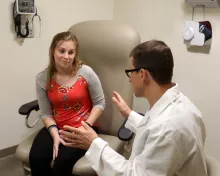Thoracic Surgery
- For all other requests:
- 1-800-777-8442
Specializing in Advanced Thoracic Surgical Repair
Our Mission
The Thoracic Surgery Program, part of the University of Iowa Heart and Vascular Center, provides comprehensive care for adults requiring lung, esophagus, diaphragm, chest and thoracic surgery. We offer the most advanced diagnostic and surgical techniques including open, minimally invasive, video and robotic-assisted procedures.
Our Approach
Our surgeons and nurses are dedicated to providing the highest quality of surgical care for all patients. Our surgical team has the most experience and expertise performing complex and routine procedures in the state of Iowa. Our state-of-the-art operating suites and multidisciplinary surgical intensive care services are available 24/7. We help you feel safe and confident in the surgical care you receive from initial consultation to post-surgery follow-up.
Our Process
Patient-centered care is our commitment and focus. We work closely with you and your family to review your medical history and condition, perform diagnostic tests as needed, and discuss your plan of care so that you are well informed and comfortable with the entire process.
Lung Conditions Treated
- Benign and malignant lesions of the lung and chest wall
- Chronic obstructive pulmonary disease (COPD, Emphysema)
- Mesothelioma
- Thoracic outlet syndrome
Treatments
Lung Treatments
- Pneumonectomy
- Removal of an entire lung, typically performed to treat lung cancer
- An open surgery with a thoracotomy incision
- VATS (video-assisted thoracic surgery) lobectomy for cancer
- Lobectomy is the removal of one or more sections (lobes) of the lung
- VATS is a minimally invasive approach that uses a small camera (thoracoscope) and special instruments
- VATS involves several small incisions, compared to one larger incision with open thoracotomy lobectomy surgery
- Benefits of the minimally invasive approach:
- Less pain after surgery
- Shorter hospital stay
- Faster recovery after surgery
- VATS (video-assisted thoracic surgery) wedge resections and segmentectomy
- Wedge resections
- Removal of a wedge-shaped piece of a lung
- Typically performed to diagnose or remove growths (nodules) in the lung
- Segmentectomy
- Removal of a larger part of the lung than with a wedge resection but not the entire lobe
- Wedge resections
Lung Volume Reduction Surgery
- Removal of an area of damaged lung which allows remaining lung tissue to expand when breathing in
- Typically for patient who have emphysema or severe chronic obstructive pulmonary disease (COPD)
Mediastinal Diseases
- Mediastinal mass (tumor) excision and biopsy
- A mediastinal tumor is a growth that forms in area of the middle of the chest between the sternum and spine and between the lungs (mediastinum)
- Mediastinoscopy for staging and diagnosis
- A mediastinoscopy is a procedure in which an instrument (mediastinoscope) is inserted in the space in the chest between the lungs (mediastinum)
- Tissue is removed (biopsy) from the lymph nodes or unusual growth (tumor) for diagnosis and staging.
- The procedure involves a small incision to inset the mediastinoscope
- Necrotizing mediastinitis
- Mediastinitis is a serious, life-threatening infection in the area between the lungs (mediastinum)
- Necrosis is the death of cells in a tissue or organ
- Surgery is performed to remove areas of infection if tissues are severely damaged
- VATS (video-assisted thoracic surgery) thymectomy
- A thymectomy is the removal of the thymus gland located in the upper part of the chest
- The thymus gland plays an important role in developing the body’s immune system
- An abnormal thymus gland or a benign tumor arising from the thymus tissue known as a thymoma can lead to an autoimmune disease called myasthenia gravis (MG), which affects the connection between nerves and skeletal muscle. MG causes muscle weakness that gets worse over time
- A thymectomy improves or eliminates the muscle weakness caused by MG
Tracheal Diseases
- Repair of tracheoesophageal fistula
- A tracheoesophageal fistula is an abnormal connection or channel between the trachea (windpipe) and esophagus
- Tracheal dilatation
- Tracheal dilatation is a treatment for tracheal stenosis, which is the narrowing of the trachea (windpipe)
- Treatment options:
- Balloon catheter
- Surgical instruments (tracheal dilators)
- Airway stents
- Tracheal resection
- Removal of the narrowed area of the trachea and the rejoining of the upper and lower sections
Chest Wall Diseases
- Open fixation repair of rib fractures and chest wall deformities
- Open surgery procedure for life-threatening conditions such as flail chest (a section of the rib cage breaks off from the chest wall) or fractures of three or more consecutive ribs
- Resection of chest wall tumors with reconstruction
- Chest wall tumors can develop in the blood vessels, bones, cartilage, muscles, nerves, and skin of the chest
- Removal (resection) of a part of the chest wall is performed to diagnose and treat patients
- Resection may include removal of ribs and muscles
- Sternotomy with reconstruction for cancer
- Removal and rebuilding of the sternum
- Thoracic outlet syndrome
- Thoracic outlet syndrome occurs when blood vessels or nerves in the upper chest area (below the neck to the first rib) are compressed
- This can cause pain, tingling, or numbness along the shoulders, arms, hands, and fingers
- Surgery to treat thoracic outlet syndrome may involve:
- Removing a piece of the first rib
- Removing muscle
- Repairing compressed blood vessels
- Thoracic outlet syndrome occurs when blood vessels or nerves in the upper chest area (below the neck to the first rib) are compressed
Diaphragmatic Diseases
- Reconstruction of diaphragm
- Repair of diaphragmatic hernias (Bochdalek, Morgagni)
- A hernia in the diaphragm is an abnormal opening that can allow the stomach and intestines in the abdominal cavity to move into the thoracic (chest) cavity and crowd the heart and lungs
- A Bochdalek hernia is a defect in the side or back of the diaphragm
- A Morgagni hernia is a defect in the front of the diaphragm
- A hernia in the diaphragm is an abnormal opening that can allow the stomach and intestines in the abdominal cavity to move into the thoracic (chest) cavity and crowd the heart and lungs
- VATS (video-assisted thoracic surgery) plication for diaphragmatic paralysis
- The diaphragm is the muscle and tissue that separates the thoracic (chest) and abdominal cavities
- Diaphragmatic paralysis causes severe breathing problems
- Diaphragmatic plication involves surgically creating “folds” in the diaphragm so that the lungs can expand more fully
Pleural Diseases
- Empyema decortication
- Empyema is the buildup of infection (pus) in the space between the lung and the inner surface of the chest wall (called the pleural space)
- In some cases, the infection hardens, which prevents the lungs from expanding normally. This makes breathing difficult.
- Decortication is the removal of the infected tissue
- Hemothorax evacuation
- Hemothorax is the buildup of blood in the space between the lung and chest wall (pleural space)
- In some cases, a chest tube is inserted to drain the blood and allow the lung to expand normally
- In severe cases, open surgery (thoracotomy) is needed
- Malignant effusion drainage and pleurodesis
- A pleural effusion is the buildup of extra fluid in the space between the lung and chest wall (pleural space)
- Cancer growing in the pleural space causes a malignant pleural effusion
- Pleural effusion drainage often requires a chest tube inserted into the pleural space to remove the extra fluid
- Pleurodesis is a procedure that causes the linings of the pleural space to stick together, which closes the space and prevents any future buildup of fluid
- Extrapleural pneumonectomy for mesothelioma
- Mesothelioma is a cancer of the protective tissue (mesothelium) that covers the lungs, heart, and abdomen
- Extrapleural pneumonectomy is the surgical removal of the diseased lung, part of the diaphragm, and the protective linings of the lungs and heart
- Pleurectomy and decortication for mesothelioma
- Surgical removal of the pleural space or mesothelium
Other Procedures
- Sympathectomy for hyperhidrosis (excessive sweating)
Our Care Team
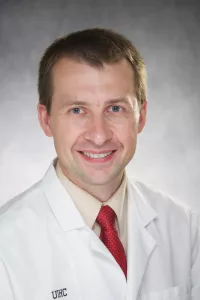
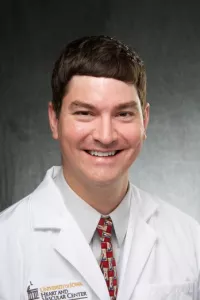
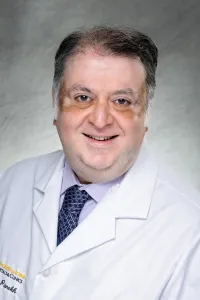
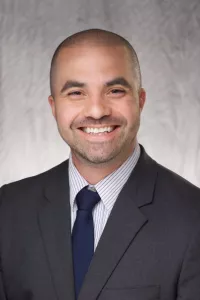
- Joan Ricks-McGillin, RN
- Kelley McLaughlin, RN
Not sure which Thoracic Surgery provider is right for you?
Locations and Offices
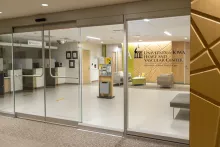
Patient Stories

